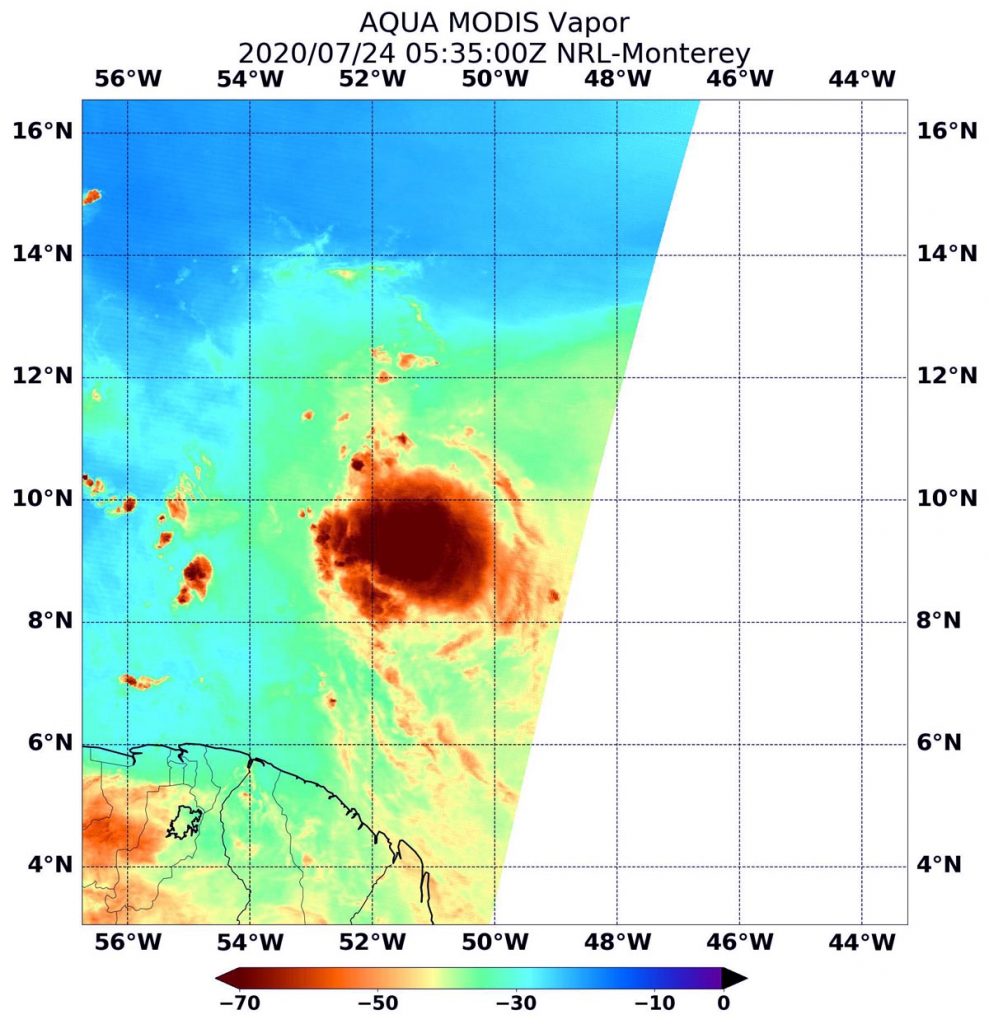July 24, 2020 – NASA Water Vapor Data Reveals Tropical Storm Gonzalo’s Soaking Capability
When NASA’s Aqua satellite passed over the North Atlantic Ocean, it gathered water vapor data on Tropical Storm Gonzalo as tropical storm warnings, a tropical storm watch, and hurricane watch were posted.

Water vapor analysis of tropical cyclones tells forecasters how much potential a storm has to develop. Water vapor releases latent heat as it condenses into liquid. That liquid becomes clouds and thunderstorms that make up a tropical cyclone. Temperature is important when trying to understand how strong storms can be. The higher the cloud tops, the colder and stronger the storms.
NASA’s Aqua satellite passed over Tropical Storm Gonzalo on July 24 at 1:35 a.m. EDT (0535 UTC) and the Moderate Resolution Imaging Spectroradiometer or MODIS instrument gathered water vapor content and temperature information. The MODIS image showed highest concentrations of water vapor and coldest cloud top temperatures were around the center of circulation.
MODIS data also showed coldest cloud top temperatures were as cold as or colder than minus 70 degrees Fahrenheit (minus 56.6 degrees Celsius) in those storms. Storms with cloud top temperatures that cold have the capability to produce heavy rainfall.
The National Hurricane Center (NHC) noted that Gonzalo is expected to produce total rain accumulations of 2 to 5 inches, with isolated maximum amounts of 7 inches in Barbados and the Windward Islands tonight (July 24) through Sunday night (July 26). Gonzalo is also expected to produce total rain accumulations of 1 to 2 inches in Trinidad and Tobago. Rainfall in Barbados and the Windward Islands could lead to life-threatening flash floods.
On July 24, a Tropical Storm Warning is in effect for St. Lucia, Barbados, St. Vincent and the Grenadines. A Hurricane Watch is in effect for Barbados, St. Vincent and the Grenadines and a Tropical Storm Watch is in effect for Tobago, Grenada and its dependencies.
At 8 a.m. EDT (1200 UTC), NHC said satellite data indicated that the center of Tropical Storm Gonzalo was located near latitude 10.0 degrees north and longitude 52.8 degrees west. Gonzalo is moving toward the west near 15 mph (24 kph). A westward to west-northwestward motion with an increase in forward speed is expected through the weekend. The estimated minimum central pressure is 1000 millibars. Maximum sustained winds are near 60 mph (95 kph) with higher gusts. Gonzalo is a small tropical cyclone. Tropical-storm-force winds extend outward up to 25 miles (35 km) from the center. Some strengthening is forecast during the next day or two, and there is still a chance that Gonzalo could become a hurricane before reaching the Windward Islands. On the forecast track, the center of Gonzalo will approach the southern Windward Islands tonight and then move across the islands on Saturday (July 25) and over the eastern Caribbean Sea on Sunday (July 26).
NASA’s Aqua satellite is one in a fleet of NASA satellites that provide data for hurricane research.
Tropical cyclones/hurricanes are the most powerful weather events on Earth. NASA’s expertise in space and scientific exploration contributes to essential services provided to the American people by other federal agencies, such as hurricane weather forecasting.
For updated forecasts, visit: www.nhc.noaa.gov.
